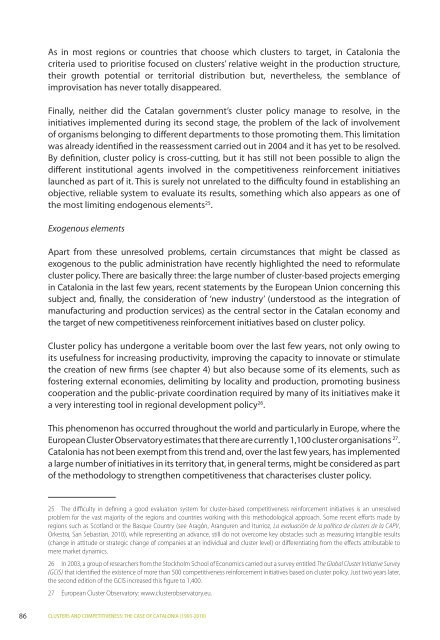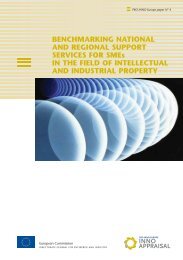Clusters and competitiveness - PRO INNO Europe
Clusters and competitiveness - PRO INNO Europe
Clusters and competitiveness - PRO INNO Europe
Create successful ePaper yourself
Turn your PDF publications into a flip-book with our unique Google optimized e-Paper software.
As in most regions or countries that choose which clusters to target, in Catalonia the<br />
criteria used to prioritise focused on clusters’ relative weight in the production structure,<br />
their growth potential or territorial distribution but, nevertheless, the semblance of<br />
improvisation has never totally disappeared.<br />
Finally, neither did the Catalan government’s cluster policy manage to resolve, in the<br />
initiatives implemented during its second stage, the problem of the lack of involvement<br />
of organisms belonging to different departments to those promoting them. This limitation<br />
was already identified in the reassessment carried out in 2004 <strong>and</strong> it has yet to be resolved.<br />
By definition, cluster policy is cross-cutting, but it has still not been possible to align the<br />
different institutional agents involved in the <strong>competitiveness</strong> reinforcement initiatives<br />
launched as part of it. This is surely not unrelated to the difficulty found in establishing an<br />
objective, reliable system to evaluate its results, something which also appears as one of<br />
the most limiting endogenous elements 25 .<br />
Exogenous elements<br />
Apart from these unresolved problems, certain circumstances that might be classed as<br />
exogenous to the public administration have recently highlighted the need to reformulate<br />
cluster policy. There are basically three: the large number of cluster-based projects emerging<br />
in Catalonia in the last few years, recent statements by the <strong>Europe</strong>an Union concerning this<br />
subject <strong>and</strong>, finally, the consideration of ‘new industry’ (understood as the integration of<br />
manufacturing <strong>and</strong> production services) as the central sector in the Catalan economy <strong>and</strong><br />
the target of new <strong>competitiveness</strong> reinforcement initiatives based on cluster policy.<br />
Cluster policy has undergone a veritable boom over the last few years, not only owing to<br />
its usefulness for increasing productivity, improving the capacity to innovate or stimulate<br />
the creation of new firms (see chapter 4) but also because some of its elements, such as<br />
fostering external economies, delimiting by locality <strong>and</strong> production, promoting business<br />
cooperation <strong>and</strong> the public-private coordination required by many of its initiatives make it<br />
a very interesting tool in regional development policy 26 .<br />
This phenomenon has occurred throughout the world <strong>and</strong> particularly in <strong>Europe</strong>, where the<br />
<strong>Europe</strong>anClusterObservatoryestimatesthattherearecurrently1,100clusterorganisations 27 .<br />
Catalonia has not been exempt from this trend <strong>and</strong>, over the last few years, has implemented<br />
a large number of initiatives in its territory that, in general terms, might be considered as part<br />
of the methodology to strengthen <strong>competitiveness</strong> that characterises cluster policy.<br />
25 The difficulty in defining a good evaluation system for cluster-based <strong>competitiveness</strong> reinforcement initiatives is an unresolved<br />
problem for the vast majority of the regions <strong>and</strong> countries working with this methodological approach. Some recent efforts made by<br />
regions such as Scotl<strong>and</strong> or the Basque Country (see Aragón, Aranguren <strong>and</strong> Iturrioz, La evaluación de la política de clusters de la CAPV,<br />
Orkestra, San Sebastian, 2010), while representing an advance, still do not overcome key obstacles such as measuring intangible results<br />
(change in attitude or strategic change of companies at an individual <strong>and</strong> cluster level) or differentiating from the effects attributable to<br />
mere market dynamics.<br />
26 In 2003, a group of researchers from the Stockholm School of Economics carried out a survey entitled The Global Cluster Initiative Survey<br />
(GCIS) that identified the existence of more than 500 <strong>competitiveness</strong> reinforcement initiatives based on cluster policy. Just two years later,<br />
the second edition of the GCIS increased this figure to 1,400.<br />
27 <strong>Europe</strong>an Cluster Observatory: www.clusterobservatory.eu.<br />
86 CLUSTERS AND COMPETITIVENESS: THE CASE OF CATALONIA (1993-2010)
















